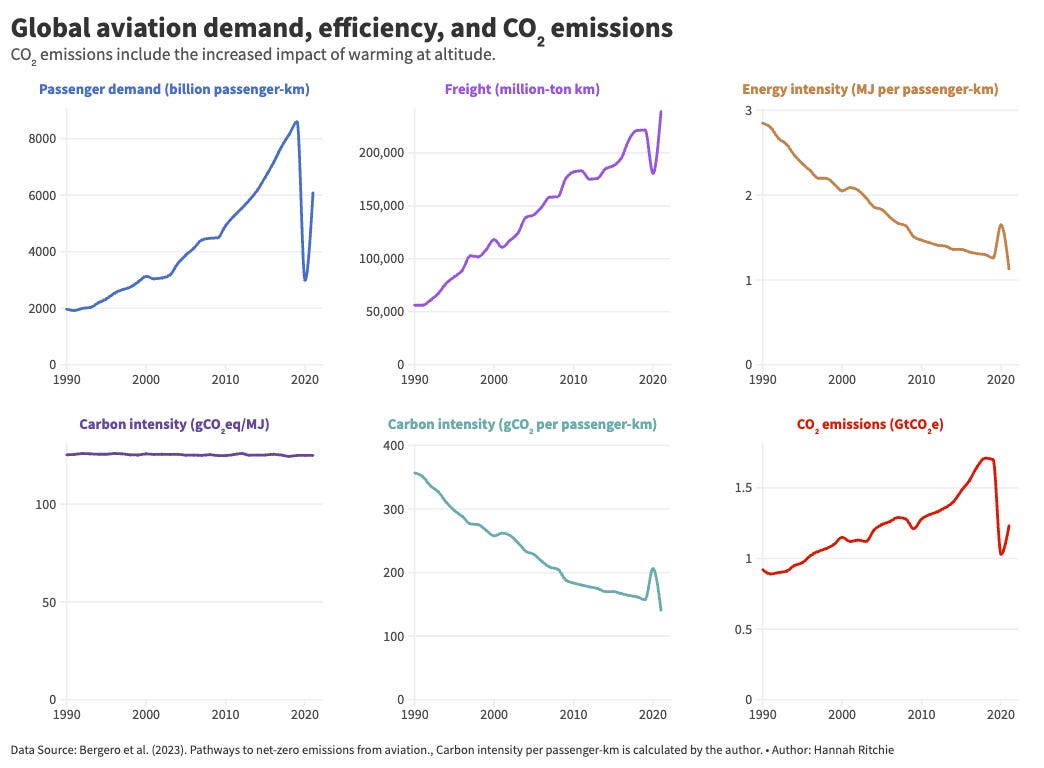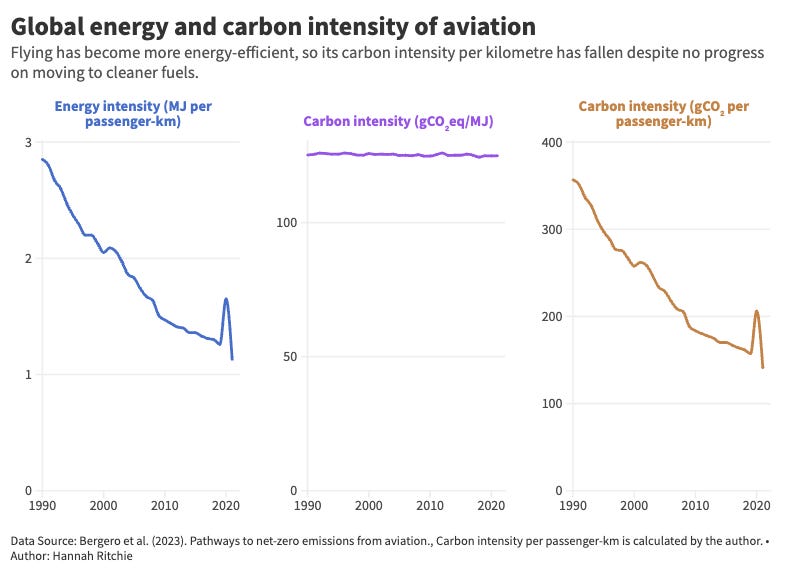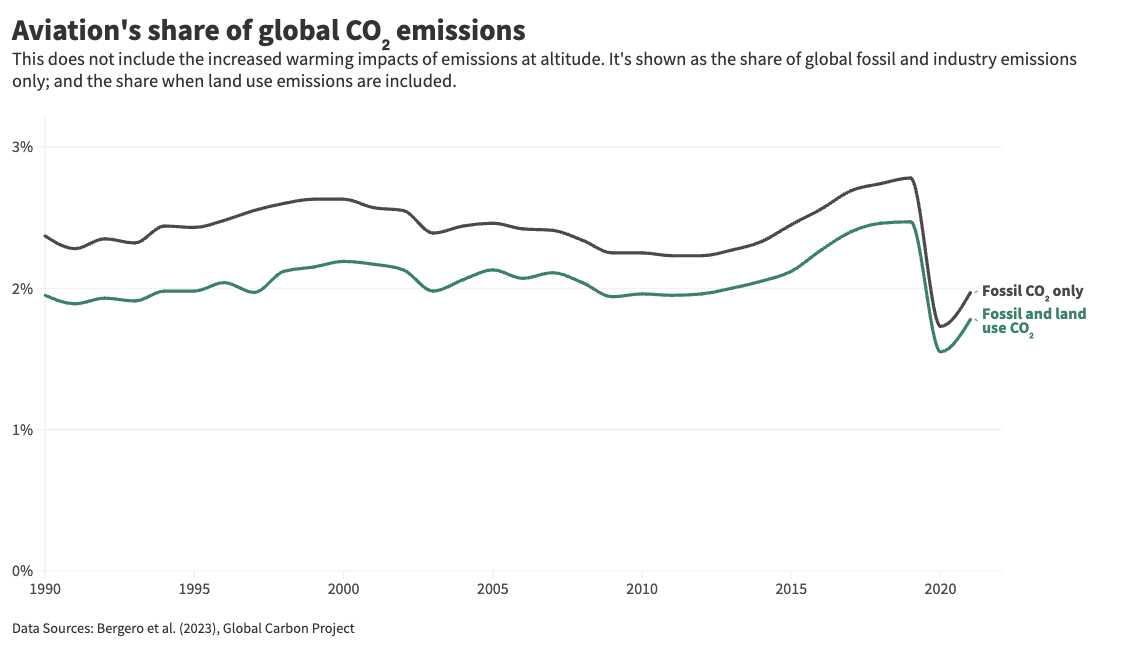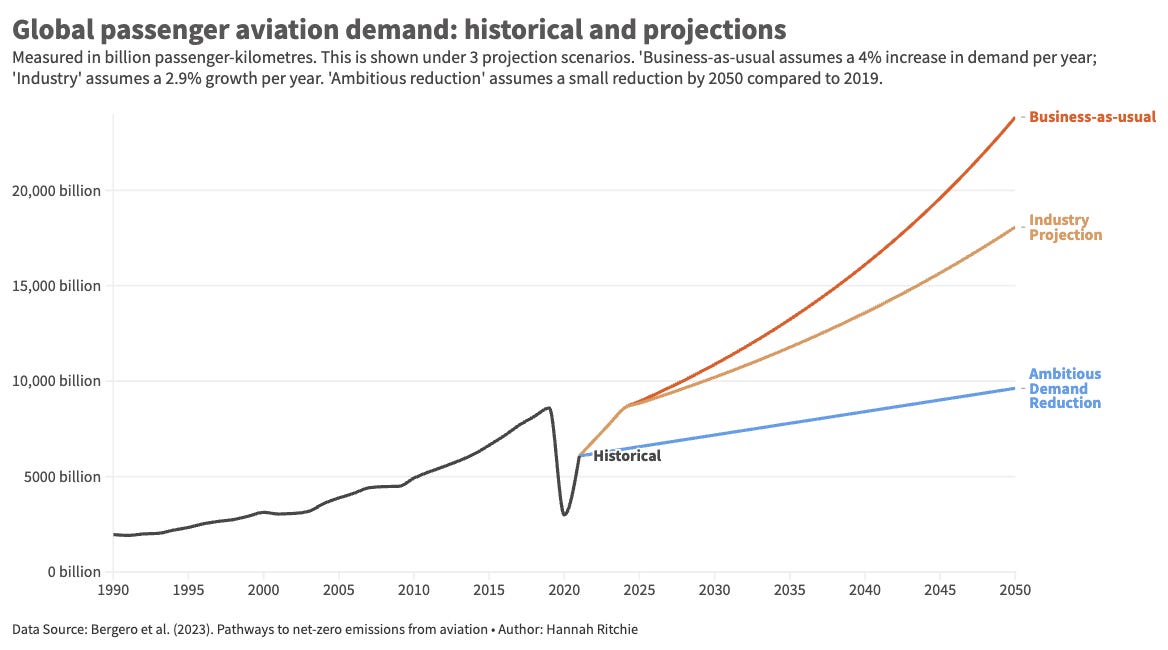How much does aviation contribute to climate change? How will this change in the future?
Aviation is responsible for around 3% of global emissions, and will be one of the hardest sectors to tackle.
This article is the first in a two-parter on global aviation. This was sparked by various questions from readers on the role of aviation in climate change, and – as a follow-up from my article on biofuels for road transport in the US – what role biofuels could play in this.Aviation will be one of the toughest sectors to decarbonise. It’s also an area that creates a lot of confusion. For those that fly, it’s one of the largest chunks of their carbon footprint. But because most people don’t fly, it emits just 2% to 3% of global emissions.
We can demonstrate the inequality of flying with a simple calculation. Let’s say everyone in the world took one return short-haul trip per year. We’ll go from London to Madrid. This would emit around 0.5 tonnes per person. For 8 billion people, this would be 4 billion tonnes of CO2.
If everyone took a long-haul return trip from London to San Fransisco, emissions would be 22 billion tonnes of CO2 from flying alone.1
In reality, global aviation emits around one billion tonnes. That’s because most people in the world don’t fly. They can’t afford it.
So, how should we think about aviation in the future? How will demand change, and what are the options to decarbonise? That’s what we’ll look at here.
For this analysis, I’ve relied heavily on an excellent paper by Candelaria Bergero and colleagues, published in Nature Sustainability in 2023.2 The future scenarios come from them, but I’ve thrown in some comparisons and additional details along the way.
Below I’ve provided a summary of global aviation metrics. They give an overview of how demand, energy efficiency and CO2 emissions have changed since 1990.
Let’s dig into the key trends one-by-one.
Global passenger demand for flying has increased four-fold since 1990
In 1990, people were travelling around 2 trillion passenger-kilometres by air. That is, the distance covered multiplied by the number of passengers on board.
By 2019, this had quadrupled to over 8 trillion passenger-kilometres.
We then see the impact of the COVID-19 pandemic. In 2020, demand plunged – almost back to 1990 levels. Demand has since started to rebound, and the airline industry expects that it will be back to 2019 levels again by 2024 or 2025.
Aviation has become more energy-efficient, but little progress has been made in moving to cleaner fuels
Flying has become much more energy-efficient. Since 1990, the amount of energy used per passenger-kilometre has more than halved. This is shown in the chart below.
You will notice that there was a spike in 2020. This was because the ‘passenger load factor’ was much lower: planes were flying with a lot more empty seats. Planes were still burning lots of fuel, but this was ‘split between’ fewer passengers.
This efficiency has come from improved design and technology, larger planes that can carry more passengers, and a higher ‘passenger load factor’. Empty seats are less common than in the past.
The amount of carbon emitted per unit of energy has not changed. We’re still burning jet fuel that releases the same amount of CO2 when burned. Alternative fuels – such as biofuels – are only a tiny part of the mix.
Combine these two factors – energy per passenger-kilometre, and the CO2 emitted per unit of energy – and we get the amount of CO2 emitted per passenger-kilometre.3 It mirrors the chart of energy intensity: rates have more than halved since 1990.
Go further back in time, and the improvements are even more impressive. As I covered in an article on Our World in Data, emissions per passenger-kilometre in 1960 were twenty-times higher than they are today.4
How much of global CO2 emissions does aviation emit?
To calculate CO2 emissions from aviation, we need to combine passenger demand and how much is emitted per passenger-kilometre (and do the same for freight).
In a world with no improvements in energy efficiency, we’d expect emissions to have quadrupled since 1990. That’s what happened to demand.
Thankfully, these efficiency improvements have dampened some of this increase. Emissions approximately doubled from 0.5 to 1 billion tonnes.
But aviation doesn’t only contribute to climate change through its CO2 emissions. It emits other greenhouse gases, and the release of water vapour at altitude significantly increases its warming impact. When we account for this, its contribution increases by around 70%.
This is shown in the chart – one line shows CO2 emissions only, and the other is shown in CO2-equivalents, with altitude impacts included.
Aviation is responsible for 2.8% of CO2 emissions from fossil fuels and industry.5 When land use change is included, it’s responsible for 2.5%. We can see how this share has changed over time in the chart below.
When its full greenhouse impacts are included, aviation is responsible for at least 3.5% of warming.6
Future demand for aviation
How will aviation demand change in the future? As people get richer, they tend to fly more. So, if incomes across the world grow, demand will increase.
Bergero et al. (2023) mapped out three growth scenarios. They’re shown below.
Business-as-usual: assumes that demand returns to pre-pandemic levels by 2024 or 2025. Then demand grows at around 4% per year. This is in line with historical growth rates, and IMF projections for economic growth.
Industry projections: Industry is slightly less bullish on demand growth. In this scenario, demand recovers to pre-pandemic levels by 2024 or 2025 then grows at around 2.9% per year.
Ambitious demand reduction: This scenario imagines strong reductions in demand. It recovers slowly and only reaches 2019 levels in 2050. Since demand will increase in low-to-middle income countries as they get richer, keeping demand lower could require large reductions in rich countries.
These demand scenarios – for passenger transport and freight – are summarised in the chart below. It shows actual demand in 2019, alongside 2050 demand in each scenario. Under the business-as-usual scenario, demand would more than double by 2050. In the ‘ambitious reduction’ scenario, it would barely increase at all.
What does this mean for the future of aviation emissions?
Future aviation emissions will not only depend on these changes in demand. They’ll also depend on improvements in energy efficiency and the adoption of low-carbon technologies.
The authors combined these demand scenarios with three technology scenarios.
Carbon-intensive: planes continue to use 100% jet fuel, as they do today. Improvements in energy efficiency continue, but the CO2 emitted per unit of energy does not change.
Reduced fossil use: 65% of medium and long-haul flights are powered by ‘sustainable’ aviation fuels (synthetic fuels such as biofuels) and 13% of short-haul flights are powered by electric planes or hydrogen by 2050. This follows the IATA’s net zero emissions plan.
Net zero: biofuels power 100% of medium- and long-haul aviation by 2050. Electric and hydrogen power 50% of short-haul flights, with the rest powered by biofuels.
The assumptions around energy and carbon intensity in each scenario are shown in the chart below.
We can then see how each of these technological scenarios affects our three demand scenarios in terms of emissions.
If we carried on a ‘business-as-usual’ path with no move away from jet fuel, annual emissions would double by 2050. In a ‘reduced fossil’ scenario, they would increase by smaller amounts, and they would fall in a ‘net zero’ pathway.
If demand growth was more modest – following the industry projection – annual emissions would only be slightly higher in a carbon-intensive pathway. They would fall in both scenarios of technological change.
Emissions would fall in a reduced demand scenario, regardless of the technological path.
Note that in all scenarios, the sector’s emissions would not reach zero. That means that to achieve ‘net-zero’, it would still need to invest in negative emissions (taking emissions out of the atmosphere). That’s billions of tonnes of negative emissions, which could be extremely expensive.
This gives us two levers for reducing emissions: cut demand, or rapidly scale technological innovations.
These alternative pathways require electrification, biofuels, and hydrogen. In particular, they rely on large amounts of biofuels. How feasible would this transition be: how does it compare to current biofuel production, and how much land would we need?
I’ll dig into this question in Part Two.
A return trip from London to San Fransisco emits around 2.8 tonnes per person.
Multiply this by 8 billion and we get 22.4 billion tonnes of CO2.
https://co2.myclimate.org/en/portfolios?calculation_id%3D6199764
Bergero, C., Gosnell, G., Gielen, D., Kang, S., Bazilian, M., & Davis, S. J. (2023). Pathways to net-zero emissions from aviation. Nature Sustainability, 6(4), 404-414.
This metric wasn't included in the supplementary material in the Bergero et al. (2023) paper, but I calculated it based on the energy and carbon intensity values.
Lee, D. S., Fahey, D. W., Skowron, A., Allen, M. R., Burkhardt, U., Chen, Q., … & Gettelman, A. (2020). The contribution of global aviation to anthropogenic climate forcing for 2000 to 2018. Atmospheric Environment, 117834.
https://www.sciencedirect.com/science/article/pii/S1352231020305689
In 2019, global CO2 emissions (excluding land use change) were 37.08 billion tonnes.
CO2 emissions from aviation were 1.04 billion tonnes.
That means aviation accounted for 2.8%.
Lee, D. S., Fahey, D. W., Skowron, A., Allen, M. R., Burkhardt, U., Chen, Q., … & Gettelman, A. (2020). The contribution of global aviation to anthropogenic climate forcing for 2000 to 2018. Atmospheric Environment, 117834.













I'd rather we worry about what we can do more easily elsewhere right now--replace fossil fuel plants with nuclear, eat less beef, solar on our roofs, and such. Solid state batteries, cheaper and better than lithium, are probably the big game changer to push the masses into EVs. I don't really like the idea of biofuels, just seems a waste of land and resources--hydrogen from renewables for airlines maybe but there's bigger fish to fry in the meantime.
Good analysis. I spent a career of 34 years working to improve the efficiency of jet engines, but after 70 years of development the modern aero-engine is a highly optimised device. There is not much more to come, and that is why industry is banking on hydrogen, electric power and sustainable aviation fuel (SAF). I think the first 2 will help short and medium haul flights a lot, but long range flights will have to rely on SAF to drastically reduce their CO2 emissions. I am sceptical that SAF will be viable, so I will be very interested in Part 2!